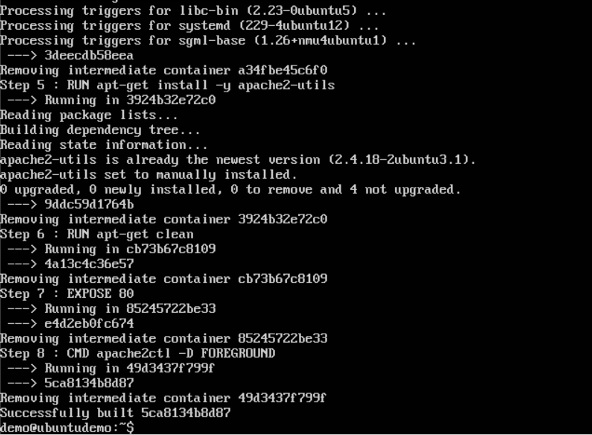

- DOCKER RUN IMAGE FROM DOCKERFILE HOW TO
- DOCKER RUN IMAGE FROM DOCKERFILE INSTALL
- DOCKER RUN IMAGE FROM DOCKERFILE PORTABLE
- DOCKER RUN IMAGE FROM DOCKERFILE FREE
You’ll notice that we did not add an ENTRYPOINT or a CMD to our Dockerfile. Next, we COPY our index.html file into the /usr/share/nginx/html directory inside the container overwriting the default index.html file provided by nginx:latest image.

This will pull the nginx:latest image to our local machine and then build our custom image on top of it. On line 1, you can see we do this using the FROM command. We start building our custom image by using a base image. index.html /usr/share/nginx/html/index.html In the same directory, create a file named Dockerfile and paste the below commands. To build a custom image, we’ll need to create a Dockerfile and add our commands to it.
DOCKER RUN IMAGE FROM DOCKERFILE PORTABLE
There are a couple of options available but one of the most portable and simplest ways to do this is to copy our html files into the image by building a custom image. But what if we want to move this image around and have our html files moved with it? Build Custom NGINX Imageīind mounts are a great option for running locally and sharing files into a running container. Open your favorite browser and navigate to and you should see the above html rendered in your browser window. This will mount our local directory ~/site-content locally into the running container at: /usr/share/nginx/html $ docker run -it -rm -d -p 8080:80 -name web -v ~/site-content:/usr/share/nginx/html nginx Now run the following command, which is the same command as above, but now we’ve added the -v flag to create a bind mount volume. In this directory add an index.html file and add the following html to it: Let’s create a custom html page and then serve that using the nginx image.Ĭreate a directory named site-content. With mounted volumes, we are able to link a directory on our local machine and map that directory into our running container. A fairly simple way to do this is use a mounted volume. We need to get our html files into this directory. $ docker stop web Adding Custom HTMLīy default, Nginx looks in the /usr/share/nginx/html directory inside of the container for files to serve. Let’s stop the container and take a look at serving our own HTML files. This is great but the purpose of running a web server is to serve our own custom html files and not the default NGINX welcome page. Open your favorite browser and navigate to You should see the following NGINX welcome page. You also named the container web using the -name option. With the above command, you started running the container as a daemon ( -d) and published port 8080 on the host network. $ docker run -it -rm -d -p 8080:80 -name web nginx Run the following command to start the container. Let’s run a basic web server using the official NGINX image. You can also see all the tags that are available by clicking on the “Tags” tab Running a basic web server On the image details screen, you are able to view the description of the image and it’s readme. Now click on the nginx result to view the image details. You will see the “OFFICIAL IMAGE” label in the top right corner of the search entry. The official NGINX image should be the first image in the search results. Once you have logged into Docker, enter “NGINX” into the top search bar and press enter. If you do not have a Docker account yet, you can create one for free. Open your favorite browser and log into Docker. Let’s take a look at the NGINX official image. These images have clear documentation, promote best practices, and are designed for the most common use cases. Official Images are a great place for new Docker users to start.


The Docker Official Images are a curated set of Docker repositories hosted on Docker Hub that have been scanned for vulnerabilities and are maintained by Docker employees and upstream maintainers. An IDE or text editor to use for editing files.
DOCKER RUN IMAGE FROM DOCKERFILE INSTALL
DOCKER RUN IMAGE FROM DOCKERFILE FREE
You can sign-up for a free Docker account and receive free unlimited public repositories.To complete this tutorial, you will need the following:
DOCKER RUN IMAGE FROM DOCKERFILE HOW TO
We’ll finish up by taking a look at creating a reverse-proxy server for a simple REST API and then how to share this image with your team. We’ll start by running a static web server locally then we’ll build a custom image to house our web server and the files it needs to serve. In this tutorial we will take a look at the NGINX Official Docker Image and how to use it. Not only is NGINX a fast and reliable static web server, it is also used by a ton of developers as a reverse-proxy that sits in front of their APIs. NGINX is one of the most popular web servers in the world.


 0 kommentar(er)
0 kommentar(er)
